Analysis of Energy Recovery Out of the Water Supply and Distribution Network of the Brussels Capital Region †
Abstract
1. Introduction
2. Materials and Methods
- ρ: water density ≈ 1000 [kg/m3]
- Q: water flow rate [m3/s]
- μ: system efficiency [-]
- g: gravitational acceleration = 9.8 [m·s−2]
- h: water height or pressure difference ΔP [m of water height]
3. Results
3.1. Energy Recovery from the WSN
WSN: Mazy Substation
3.2. Operational Implications and Investment Viability
3.3. Economic Valuation and Market Analysis
- GV2 = 5816 × 72.6 = EUR 422,241 over four years (EUR 105,560/year average)
- GV7 = 4309 × 72.6 = EUR 312,833 over four years (EUR 78,208 /year average)
3.3.1. WSN: Plancenoit Substation
3.3.2. Hydraulic Interdependencies: Mazy–Plancenoit System Analysis
3.3.3. Callois Substation
3.4. Energy Recovery from the WDN
3.4.1. Rhode Substation
3.4.2. Boistfort Substation
3.4.3. Mutual Influence from Pressure Variation in V25 in Mazy on the WDN
4. Discussion
5. Conclusions
Author Contributions
Funding
Data Availability Statement
Conflicts of Interest
References
- Agathokleous, A.; Christodoulou, S. Vulnerability of Urban Water Distribution Networks under Intermittent Water Supply Operations. Water Resour. Manag. 2016, 30, 4731–4750. [Google Scholar] [CrossRef]
- Ameyaw, E.E.; Memon, F.A.; Bicik, J. Improving equity in intermittent water supply systems. J. Water Supply Res. Technol.-Aqua 2013, 62, 552–562. [Google Scholar] [CrossRef]
- Galaitsi, S.; Russell, R.; Bishara, A.; Durant, J.; Bogle, J.; Huber-Lee, A. Intermittent Domestic Water Supply: A Critical Review and Analysis of Causal-Consequential Pathways. Water 2016, 8, 274. [Google Scholar] [CrossRef]
- Gottipati, P.V.K.S.V.; Nanduri, U.V. Equity in water supply in intermittent water distribution networks: Equity in water supply. Water Environ. J. 2014, 28, 509–515. [Google Scholar] [CrossRef]
- Ilaya-Ayza, A.E.; Benítez, J.; Izquierdo, J.; Pérez-García, R. Multi-criteria optimization of supply schedules in intermittent water supply systems. J. Comput. Appl. Math. 2017, 309, 695–703. [Google Scholar] [CrossRef]
- Mokssit, A.; de Gouvello, B.; Chazerain, A.; Figuères, F.; Tassin, B. Building a Methodology for Assessing Service Quality under Intermittent Domestic Water Supply. Water 2018, 10, 1164. [Google Scholar] [CrossRef]
- AbdelMeguid, H.; Ulanicki, B. Pressure and Leakage Management in Water Distribution Systems via Flow Modulation PRVs. In Water Distribution Systems Analysis 2010, Proceedings of the 12th Annual Conference on Water Distribution Systems Analysis, Tucson, AZ, USA, 12–15 September 2010; American Society of Civil Engineers: Reston, VA, USA, 2011; pp. 1124–1139. [Google Scholar] [CrossRef]
- Adedeji, K.B.; Hamam, Y.; Abe, B.T.; Abu-Mahfouz, A.M. Towards Achieving a Reliable Leakage Detection and Localization Algorithm for Application in Water Piping Networks: An Overview. IEEE Access 2017, 5, 20272–20285. [Google Scholar] [CrossRef]
- Araujo, L.S.; Ramos, H.; Coelho, S.T. Pressure Control for Leakage Minimisation in Water Distribution Systems Management. Water Resour. Manag. 2006, 20, 133–149. [Google Scholar] [CrossRef]
- Ávila, C.A.M.; Sánchez-Romero, F.-J.; López-Jiménez, P.A.; Leakage, M.P.-S. Management and Pipe System Efficiency. Its Influence in the Improvement of the Efficiency Indexes. Water 2021, 13, 1909. [Google Scholar] [CrossRef]
- Mosetlhe, T.C.; Hamam, Y.; Du, S.; Monacelli, E. Appraising the Impact of Pressure Control on Leakage Flow in Water Distribution Networks. Water 2021, 13, 2617. [Google Scholar] [CrossRef]
- Thornton, J. Leakage Management: A Practical Approach: 20–22 November, 2002, Lemesos, Cyprus: Conference Proceedings; Water Board of Lemesos: Lemesos, Cyprus, 2002. [Google Scholar]
- Walski, T.; Bezts, W.; Posluszny, E.T.; Weir, M.; Whitman, B.E. Modeling leakage reduction through pressure control. J. —Am. Water Work. Assoc. 2006, 98, 147–155. [Google Scholar] [CrossRef]
- Monsef, H.; Naghashzadegan, M.; Farmani, R.; Jamali, A. Pressure management in water distribution systems in order to reduce energy consumption and background leakage. J. Water Supply Res. Technol. 2018, 67, 397–403. [Google Scholar] [CrossRef]
- Abdelsalam, A.A.; Gabbar, H.A. Energy saving and management of water pumping networks. Heliyon 2021, 7, e07820. [Google Scholar] [CrossRef] [PubMed]
- Coelho, B.; Andrade-Campos, A. Efficiency achievement in water supply systems—A review. Renew. Sustain. Energy Rev. 2014, 30, 59–84. [Google Scholar] [CrossRef]
- Creaco, E.; Pezzinga, G. Comparison of Algorithms for the Optimal Location of Control Valves for Leakage Reduction in WDNs. Water 2018, 10, 466. [Google Scholar] [CrossRef]
- Gullotta, A.; Campisano, A.; Creaco, E.; Modica, C. A Simplified Methodology for Optimal Location and Setting of Valves to Improve Equity in Intermittent Water Distribution Systems. Water Resour. Manag. 2021, 35, 4477–4494. [Google Scholar] [CrossRef]
- Abdel-Mottaleb, N.; Saghand, P.G.; Wakhungu, M.J.; Charkhgard, H.; Wells, E.C.; Zhang, Q. Identifying Critical Isolation Valves in a Water Distribution Network: A Socio-Technical Approach. Water 2022, 14, 3587. [Google Scholar] [CrossRef]
- Chen, J.; Yang, H.X.; Liu, C.P.; Lau, C.H.; Lo, M. A novel vertical axis water turbine for power generation from water pipelines. Energy 2013, 54, 184–193. [Google Scholar] [CrossRef]
- Hamlehdar, M.; Yousefi, H.; Noorollahi, Y.; Mohammadi, M. Energy recovery from water distribution networks using micro hydropower: A case study in Iran. Energy 2022, 252, 124024. [Google Scholar] [CrossRef]
- Balacco, G.; Binetti, M.; Capurso, T.; Stefanizzi, M.; Torresi, M.; Piccinni, A.F. Pump as Turbine for the Energy Recovery in a Water Distribution Network: Two Italian (Apulian) Case Studies. Environ. Sci. Proc. 2020, 2, 1. [Google Scholar] [CrossRef]
- Kramer, M.; Terheiden, K.; Wieprecht, S. Pumps as turbines for efficient energy recovery in water supply networks. Renew. Energy 2018, 122, 17–25. [Google Scholar] [CrossRef]
- Souza, D.E.S.E.; Mesquita, A.L.A.; Blanco, C.J.C. Pump-as-turbine for energy recovery in municipal water supply networks. A review. J. Braz. Soc. Mech. Sci. Eng. 2021, 43, 489. [Google Scholar] [CrossRef]
- Stefanizzi, M.; Capurso, T.; Balacco, G.; Binetti, M.; Camporeale, S.M.; Torresi, M. Selection, control and techno-economic feasibility of Pumps as Turbines in Water Distribution Networks. Renew. Energy 2020, 162, 1292–1306. [Google Scholar] [CrossRef]
- Kostner, M.K.; Zanfei, A.; Alberizzi, J.C.; Renzi, M.; Righetti, M.; Menapace, A. Micro hydro power generation in water distribution networks through the optimal pumps-as-turbines sizing and control. Appl. Energy 2023, 351, 121802. [Google Scholar] [CrossRef]
- Vicente, D.J.; Garrote, L.; Sánchez, R.; Santillán, D. Pressure Management in Water Distribution Systems: Current Status, Proposals, and Future Trends. J. Water Resour. Plann. Manag. 2016, 142, 04015061. [Google Scholar] [CrossRef]
- Page, P.R.; Abu-Mahfouz, A.M.; Mothetha, M.L. Pressure Management of Water Distribution Systems via the Remote Real-Time Control of Variable Speed Pumps. J. Water Resour. Plann. Manag. 2017, 143, 04017045. [Google Scholar] [CrossRef]
- Mathye, R.P.; Scholz, M.; Nyende-Byakika, S. Optimal Pressure Management in Water Distribution Systems: Efficiency Indexes for Volumetric Cost Performance, Consumption and Linear Leakage Measurements. Water 2022, 14, 805. [Google Scholar] [CrossRef]
- Mitrovic, D.; Chacón, M.C.; García, A.M.; Morillo, J.G.; Diaz, J.A.R.; Ramos, H.M.; Adeyeye, K.; Carravetta, A.; McNabola, A. Multi-Country Scale Assessment of Available Energy Recovery Potential Using Micro-Hydropower in Drinking, Pressurised Irrigation and Wastewater Networks, Covering Part of the EU. Water 2021, 13, 899. [Google Scholar] [CrossRef]
- García, A.M.; Díaz, J.R.; Morillo, J.G.; McNabola, A. Energy Recovery Potential in Industrial and Municipal Wastewater Networks Using Micro-Hydropower in Spain. Water 2021, 13, 691. [Google Scholar] [CrossRef]
- Pérez-Sánchez, M.; Sánchez-Romero, F.J.; Ramos, H.M.; López-Jiménez, P.A. Improved Planning of Energy Recovery in Water Systems Using a New Analytic Approach to PAT Performance Curves. Water 2020, 12, 468. [Google Scholar] [CrossRef]
- Chacón, M.C.; Díaz, J.A.R.; Morillo, J.G.; McNabola, A. Evaluation of the design and performance of a micro hydropower plant in a pressurised irrigation network: Real world application at farm-level in Southern Spain. Renew. Energy 2021, 169, 1106–1120. [Google Scholar] [CrossRef]
- Liebensteiner, M.; Ocker, F.; Abuzayed, A. High electricity price despite expansion in renewables: How market trends shape Germany’s power market in the coming years. Energy Policy 2025, 198, 114448. [Google Scholar] [CrossRef]
- Babatunde, O.M.; Munda, J.L.; Hamam, Y. Power system flexibility: A review. Energy Rep. 2020, 6, 101–106. [Google Scholar] [CrossRef]
- Palade, D. Research on Power Aggregators within the European Internal Electricity Market. Proc. Int. Conf. Bus. Excell. 2023, 17, 129–138. [Google Scholar] [CrossRef]
- Awe, O.M.; Okolie, S.T.A.; Fayomi, O.S.I. Review of Water Distribution Systems Modelling and Performance Analysis Softwares. J. Phys. Conf. Ser. 2019, 1378, 022067. [Google Scholar] [CrossRef]
- Creaco, E.; Campisano, A.; Fontana, N.; Marini, G.; Page, P.R.; Walski, T. Real time control of water distribution networks: A state-of-the-art review. Water Res. 2019, 161, 517–530. [Google Scholar] [CrossRef] [PubMed]
- Sonaje, N.P.; Joshi, M.G. A review of modeling and application of water distribution networks (WDN) softwares. Int. J. Tech. Res. Appl. 2015, 3, 6. [Google Scholar]
- Kowalska, B.; Suchorab, P.; Kowalski, D. Division of district metered areas (DMAs) in a part of water supply network using WaterGEMS (Bentley) software: A case study. Appl. Water Sci. 2022, 12, 166. [Google Scholar] [CrossRef]
- Surco, D.F.; Vecchi, T.P.B.; Ravagnani, M.A.S.S. Optimization of water distribution networks using a modified particle swarm optimization algorithm. Water Supply 2018, 18, 660–678. [Google Scholar] [CrossRef]
- Abunada, M.; Trifunović, N.; Kennedy, M.; Babel, M. Optimization and Reliability Assessment of Water Distribution Networks Incorporating Demand Balancing Tanks. Procedia Eng. 2014, 70, 4–13. [Google Scholar] [CrossRef]
- Cheung, P.B.; Reis, L.F.R.; Formiga, K.T.M.; Chaudhry, F.H.; Ticona, W.G.C. Multiobjective Evolutionary Algorithms Applied to the Rehabilitation of a Water Distribution System: A Comparative Study. In Evolutionary Multi-Criterion Optimization; Fonseca, C.M., Fleming, P.J., Zitzler, E., Thiele, L., Deb, K., Eds.; Lecture Notes in Computer Science; Springer: Berlin/Heidelberg, Germany, 2003; Volume 2632, pp. 662–676. [Google Scholar] [CrossRef]
- Adedeji, K.B.; Hamam, Y.; Abe, B.T.; Abu-Mahfouz, A.M. Pressure Management Strategies for Water Loss Reduction in Large-Scale Water Piping Networks: A Review. In Advances in Hydroinformatics; Gourbesville, P., Cunge, J., Caignaert, G., Eds.; Springer Water; Springer: Singapore, 2018; pp. 465–480. [Google Scholar] [CrossRef]
- Alvisi, S.; Franchini, M. A Procedure for the Design of District Metered Areas in Water Distribution Systems. Procedia Eng. 2014, 70, 41–50. [Google Scholar] [CrossRef]
- Kim, T.; Oh, Y.; Koo, J.; Yoo, D. Evaluation of Priority Control District Metered Area for Water Distribution Networks Using Water Quality-Related Big Data. Sustainability 2022, 14, 7282. [Google Scholar] [CrossRef]
- Sinagra, M.; Creaco, E.; Morreale, G.; Tucciarelli, T. Energy Recovery Optimization by Means of a Turbine in a Pressure Regulation Node of a Real Water Network Through a Data-Driven Digital Twin. Water Resour. Manag. 2023, 37, 4733–4749. [Google Scholar] [CrossRef]
- Morabito, A.; Hendrick, P. Pump as turbine applied to micro energy storage and smart water grids: A case study. Appl. Energy 2019, 241, 567–579. [Google Scholar] [CrossRef]
- Stefanizzi, M.; Capurso, T.; Balacco, G.; Binetti, M.; Torresi, M.; Camporeale, S.M. Pump as turbine for throttling energy recovery in water distribution networks. Presented at the Second international conference on material science, smart structures and applications. AIP Conf. Proc. 2019, 2191, 020142. [Google Scholar] [CrossRef]
- Giugni, M.; Fontana, N.; Ranucci, A. Optimal Location of PRVs and Turbines in Water Distribution Systems. J. Water Resour. Plann. Manag. 2014, 140, 06014004. [Google Scholar] [CrossRef]
- Morabito, A.; Furtado, G.C.A.; Mesquita, A.L.A.; Hendrick, P. Variables speed regulation for pump as turbine in a micro pumped hydro energy storage application. Presented at the 38th IAHR World Congress, Panama City, Panama, 1–6 September 2019; pp. 4039–4046. [Google Scholar] [CrossRef]
- Mercier, T.; Hardy, C.; Van Tichelen, P.; Olivier, M.; De Jaeger, E. Control of variable-speed pumps used as turbines for flexible grid-connected power generation. Electr. Power Syst. Res. 2019, 176, 105962. [Google Scholar] [CrossRef]
- Pirard, T.; Kitsikoudis, V.; Erpicum, S.; Pirotton, M.; Archambeau, P.; Dewals, B. Discharge Redistribution as a Key Process for Heuristic Optimization of Energy Production with Pumps as Turbines in a Water Distribution Network. Water Resour. Manag. 2022, 36, 1237–1250. [Google Scholar] [CrossRef]
- Ramos, H.M.; Teyssier, C.; Samora, I.; Schleiss, A.J. Energy recovery in SUDS towards smart water grids: A case study. Energy Policy 2013, 62, 463–472. [Google Scholar] [CrossRef]
- Sinagra, M.; Aricò, C.; Tucciarelli, T.; Amato, P.; Fiorino, M. Coupled Electric and Hydraulic Control of a PRS Turbine in a Real Transport Water Network. Water 2019, 11, 1194. [Google Scholar] [CrossRef]
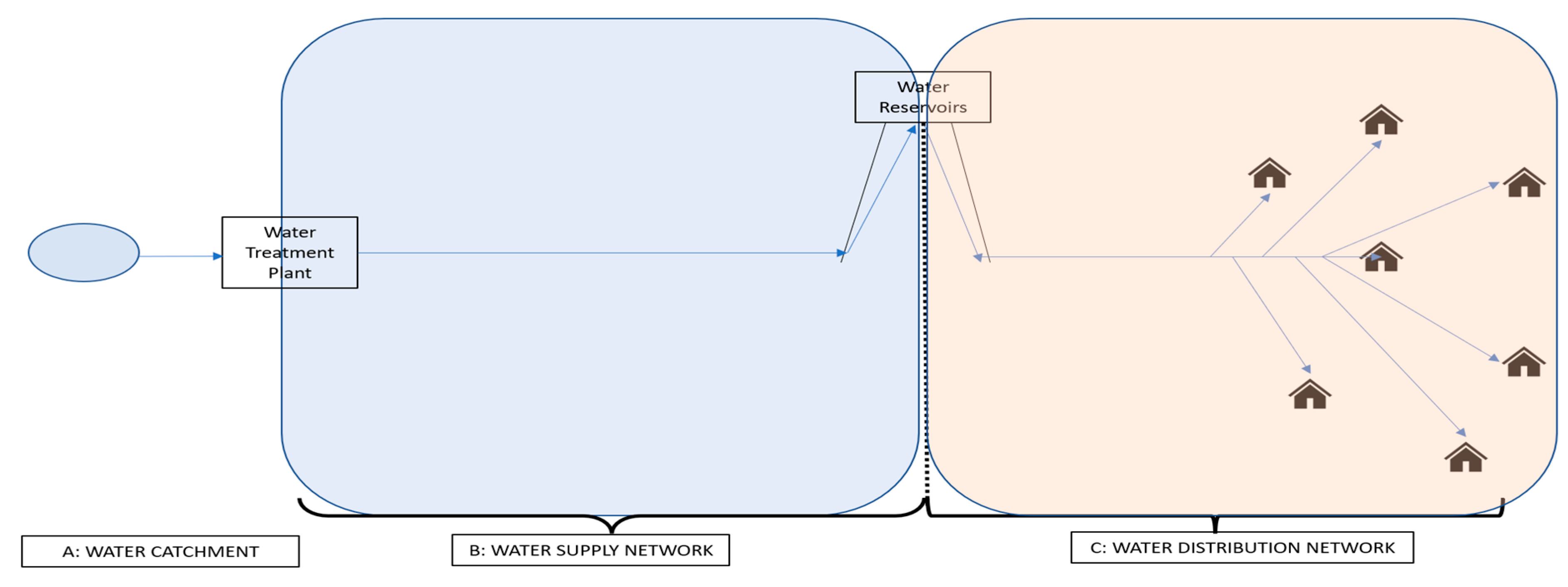
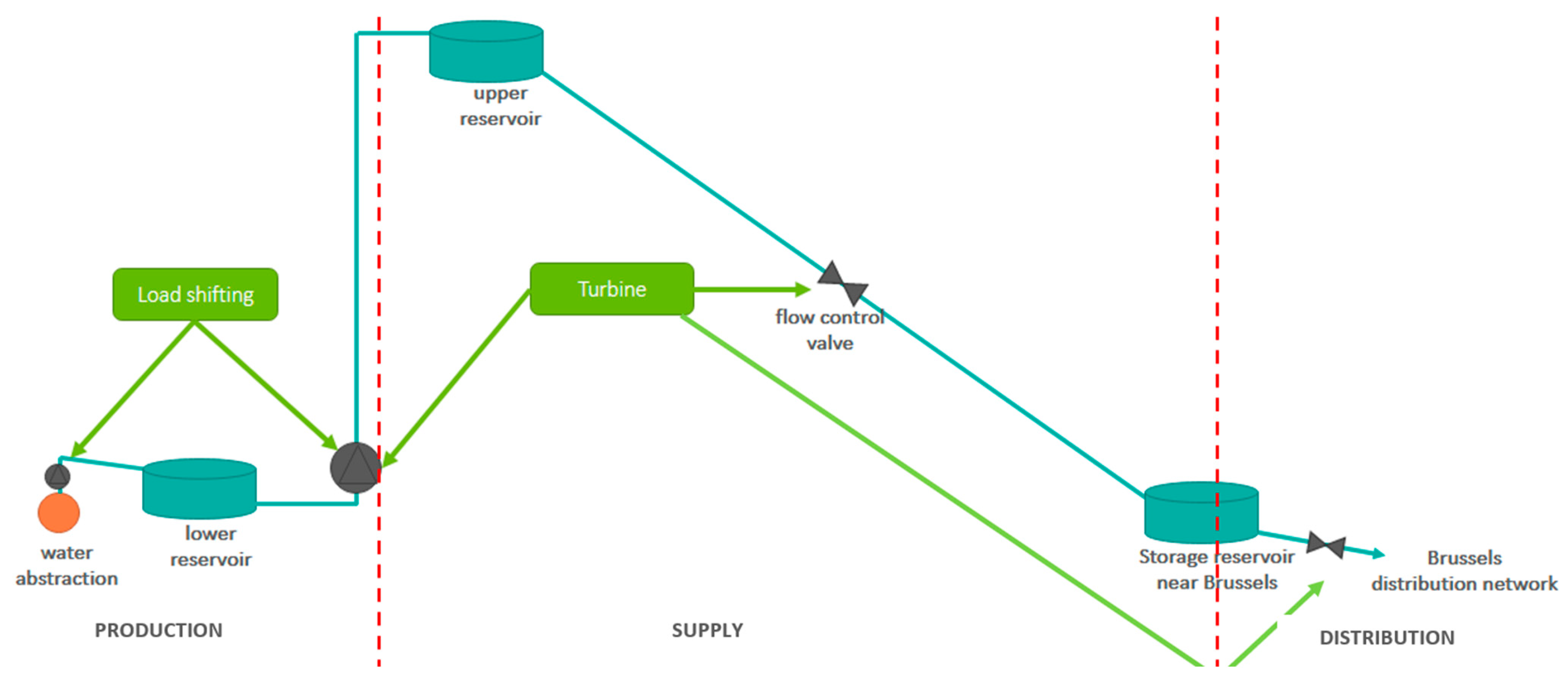
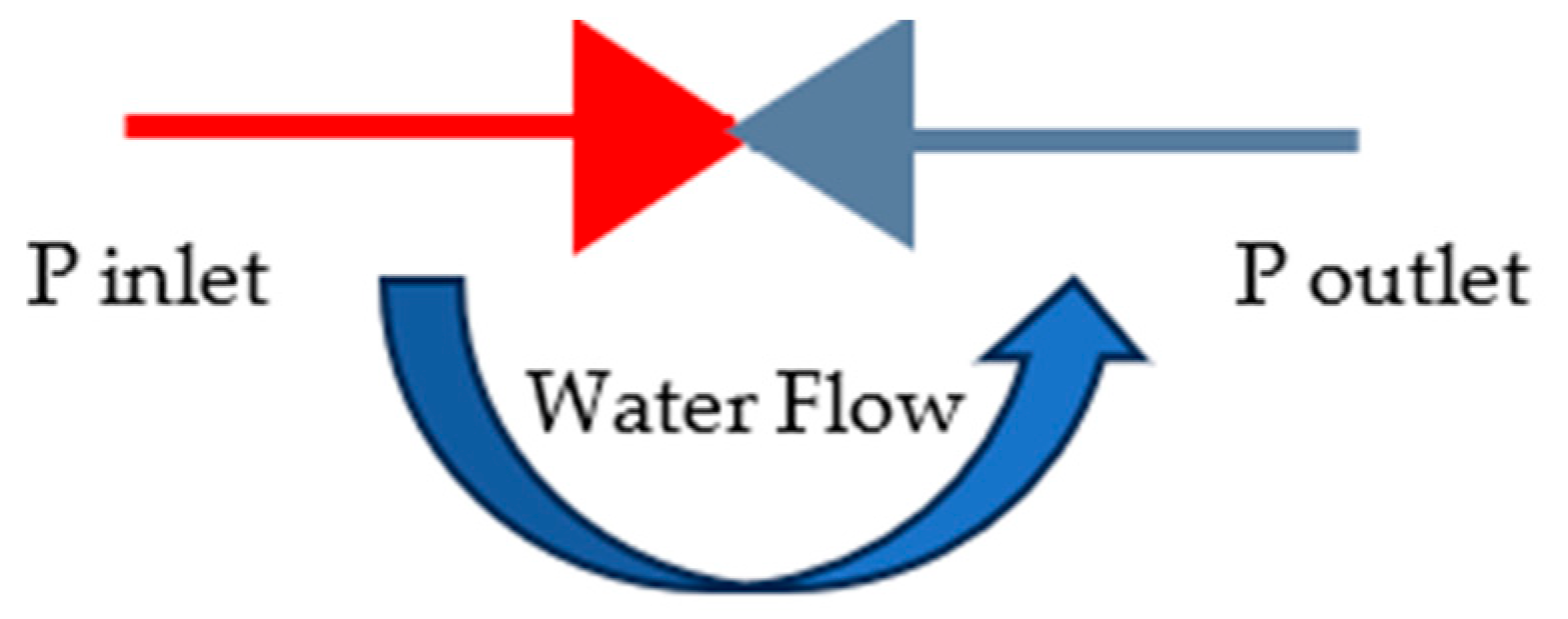
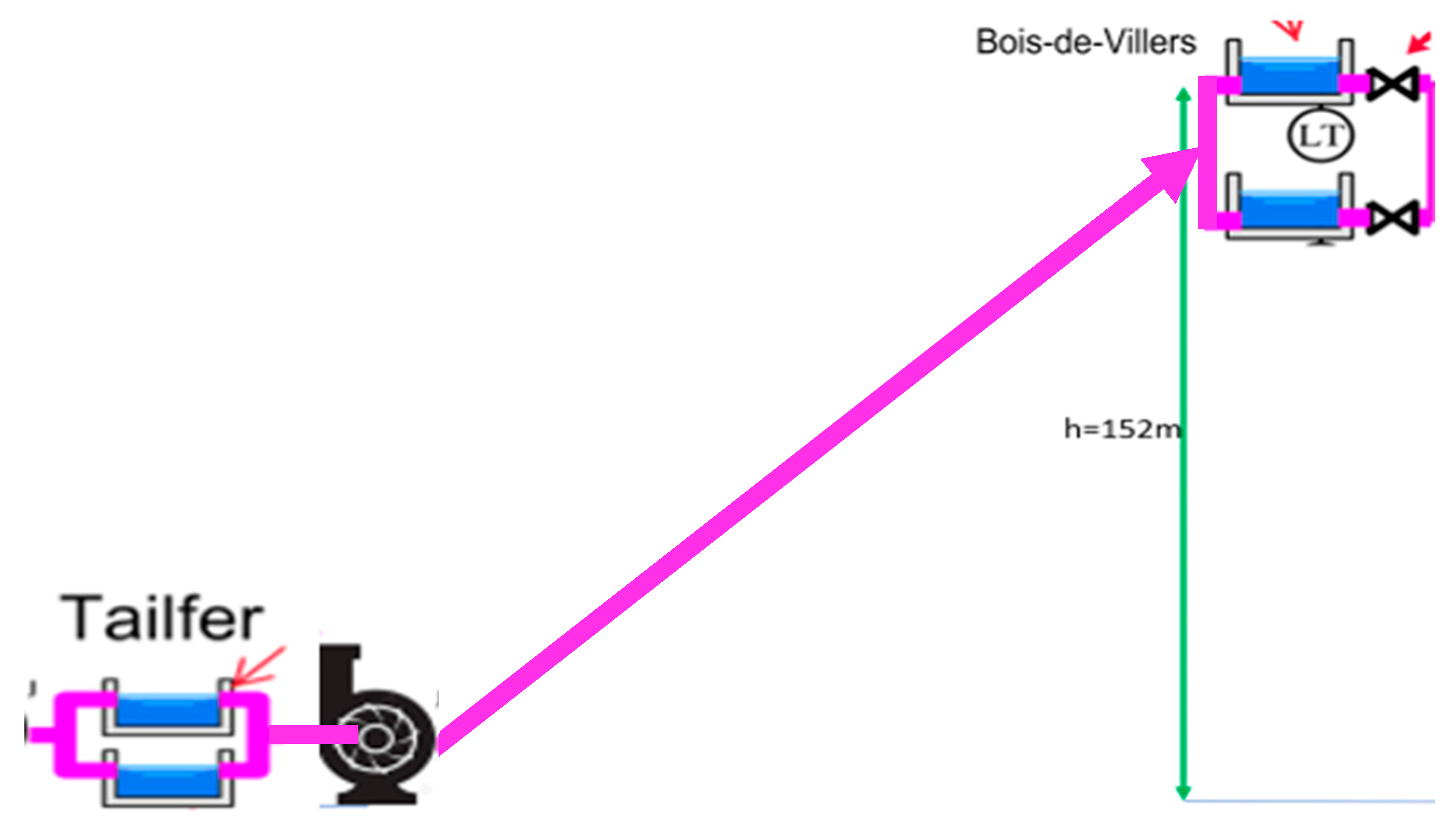
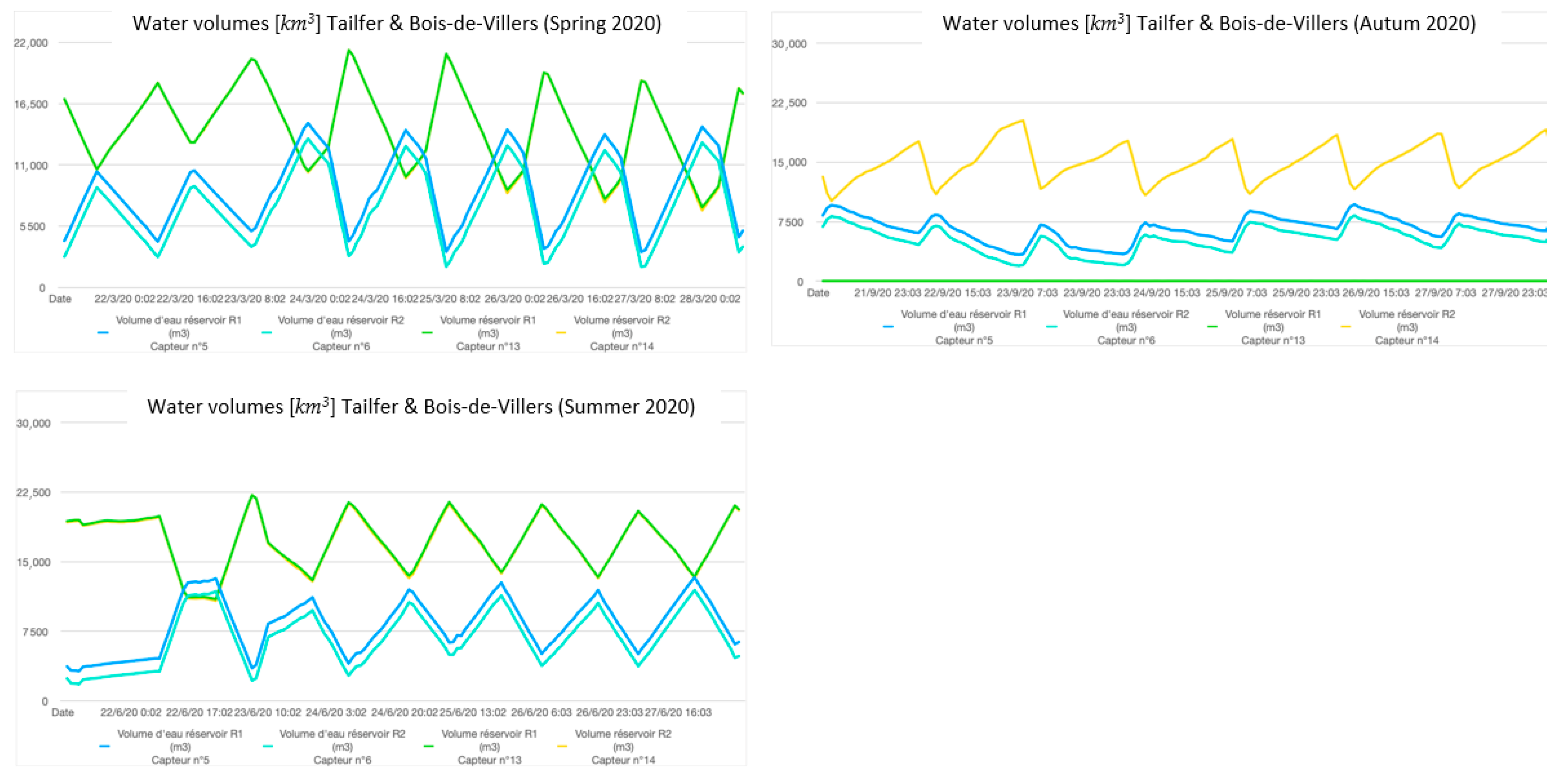
 represents the water intake, i.e., the place where the water is pumped out (river, cave, or mine);
represents the water intake, i.e., the place where the water is pumped out (river, cave, or mine);  represents the water treatment plant, i.e., the place where the water is treated to make it drinkable;
represents the water treatment plant, i.e., the place where the water is treated to make it drinkable;  represents the node of the network, i.e., the place where the WSN subdivides into other branches; and
represents the node of the network, i.e., the place where the WSN subdivides into other branches; and  represents the reservoirs of the network, i.e., the place where the water is stored.
represents the reservoirs of the network, i.e., the place where the water is stored.
 represents the water intake, i.e., the place where the water is pumped out (river, cave, or mine);
represents the water intake, i.e., the place where the water is pumped out (river, cave, or mine);  represents the water treatment plant, i.e., the place where the water is treated to make it drinkable;
represents the water treatment plant, i.e., the place where the water is treated to make it drinkable;  represents the node of the network, i.e., the place where the WSN subdivides into other branches; and
represents the node of the network, i.e., the place where the WSN subdivides into other branches; and  represents the reservoirs of the network, i.e., the place where the water is stored.
represents the reservoirs of the network, i.e., the place where the water is stored.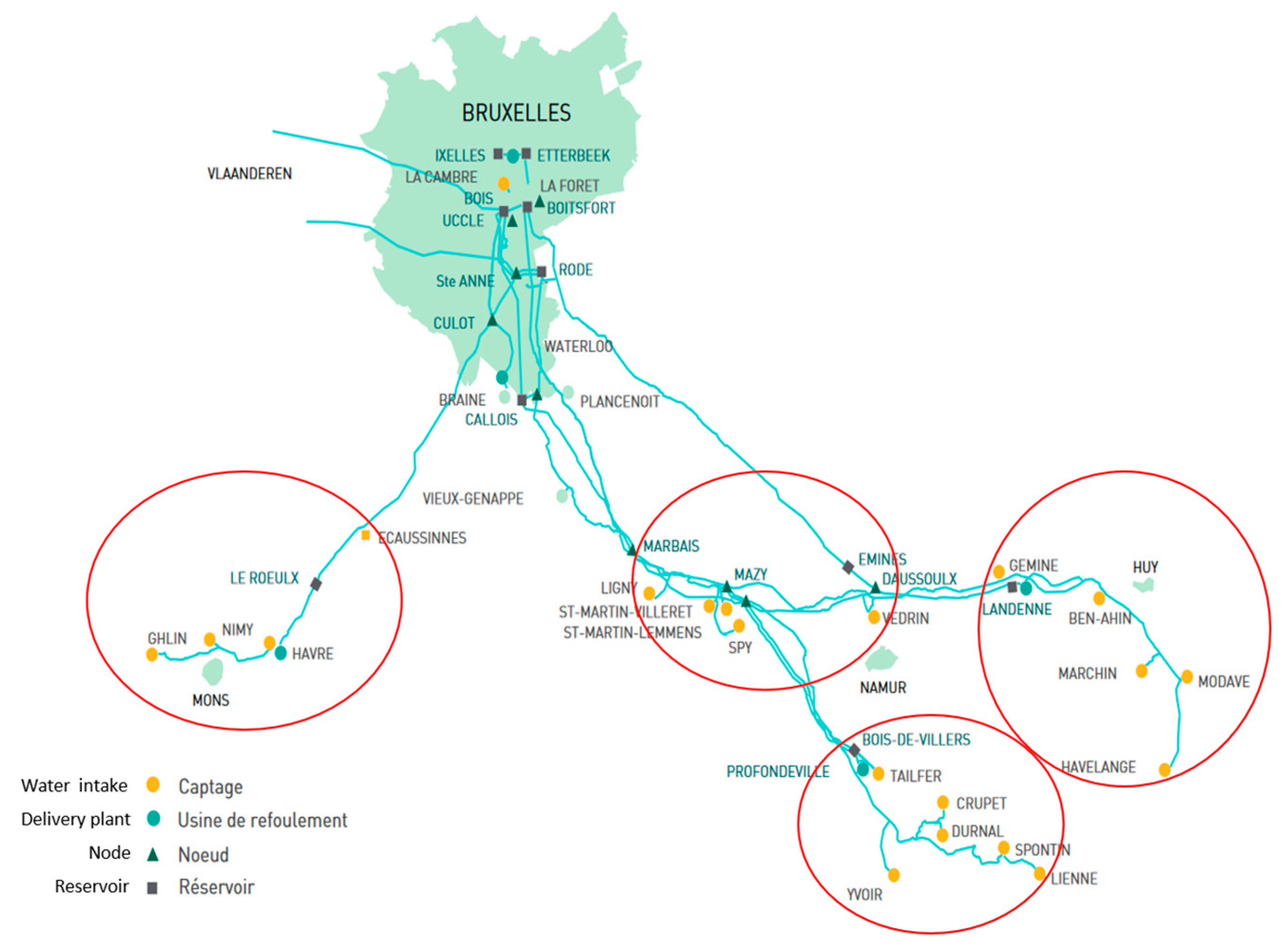
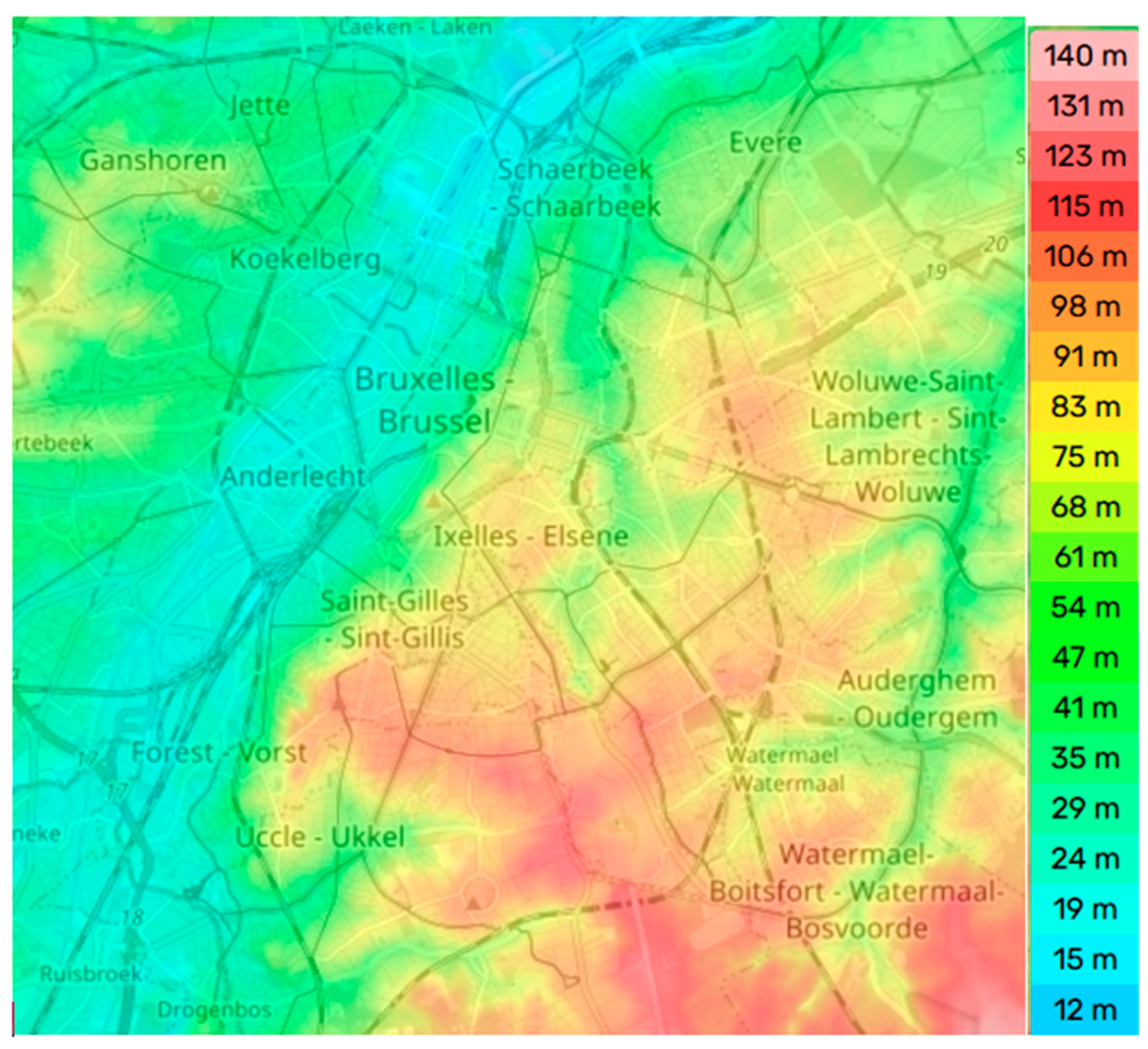
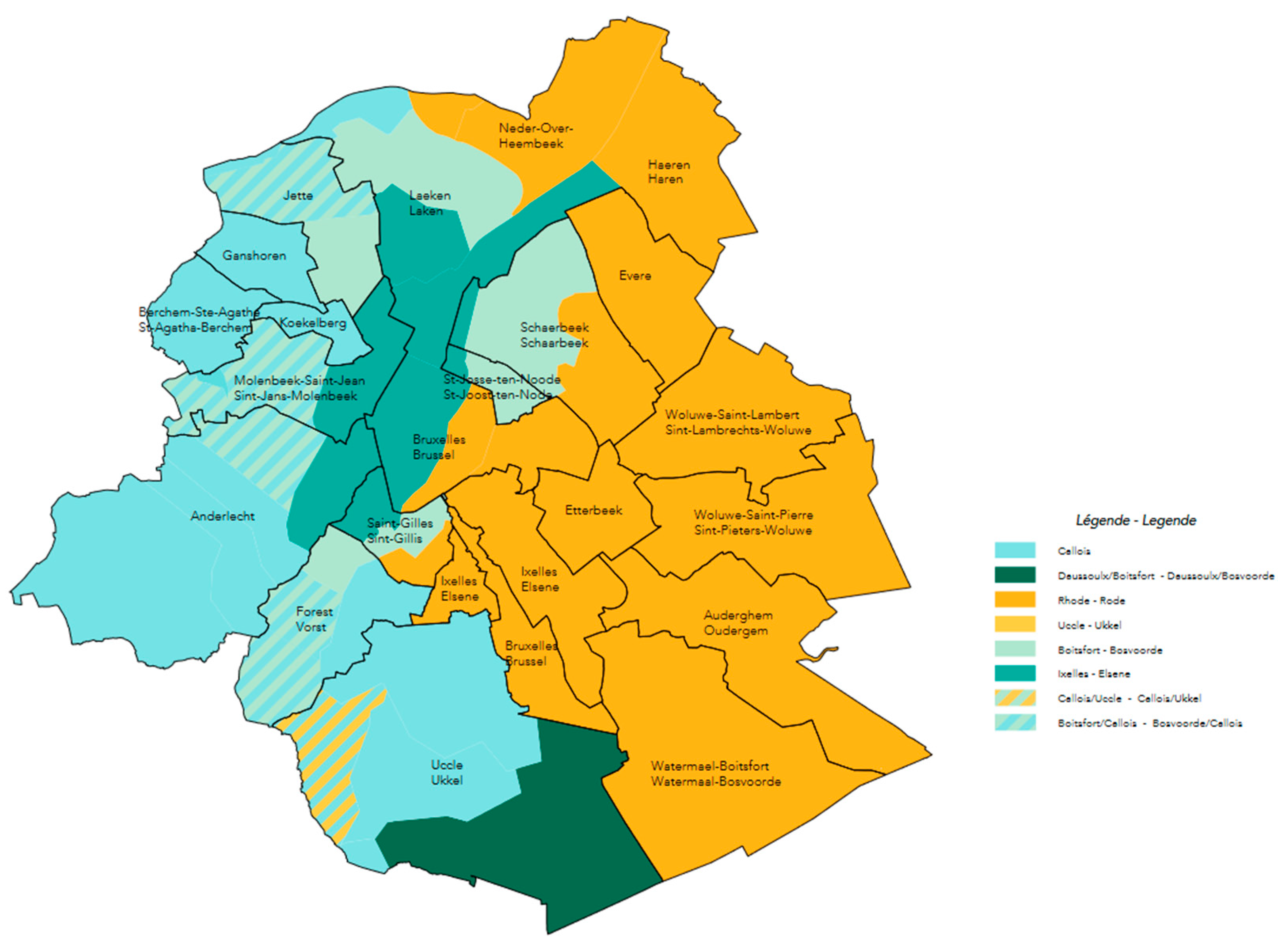
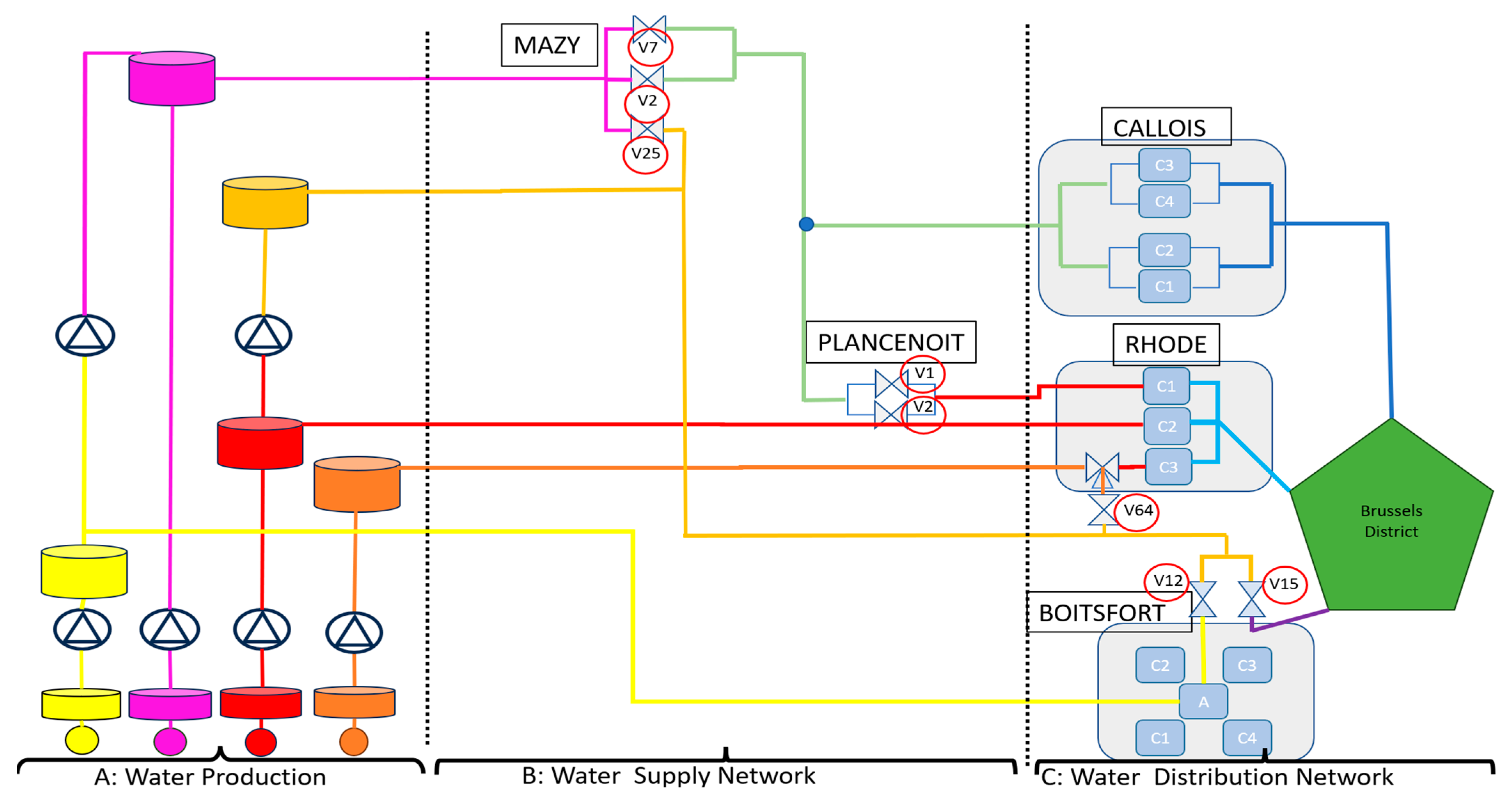
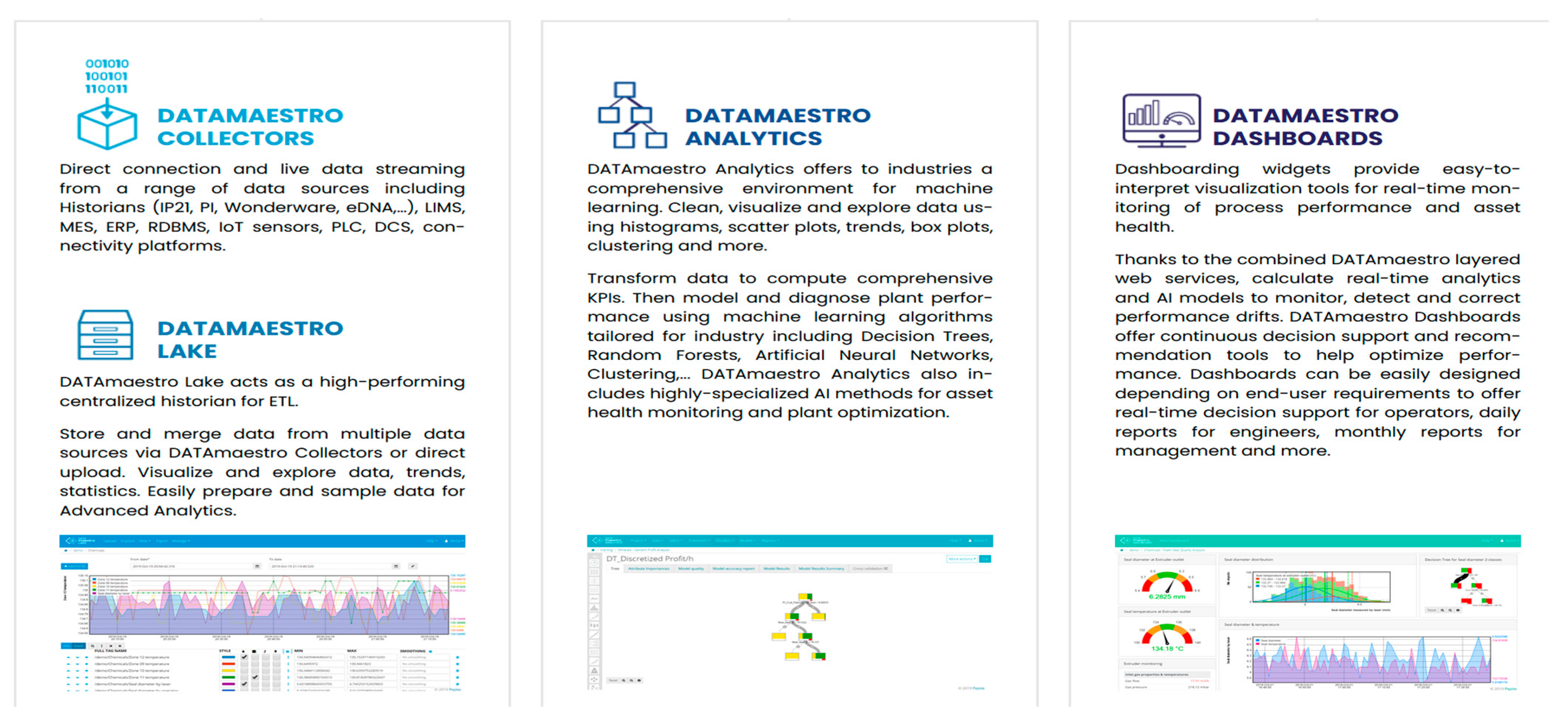
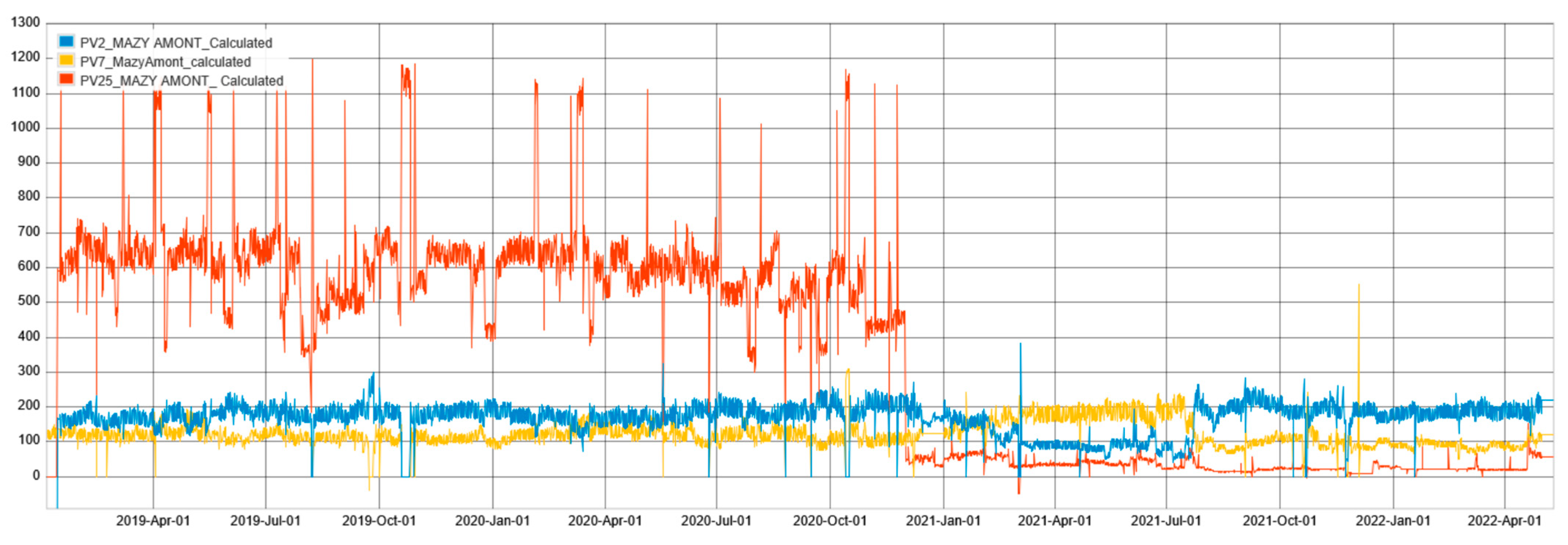
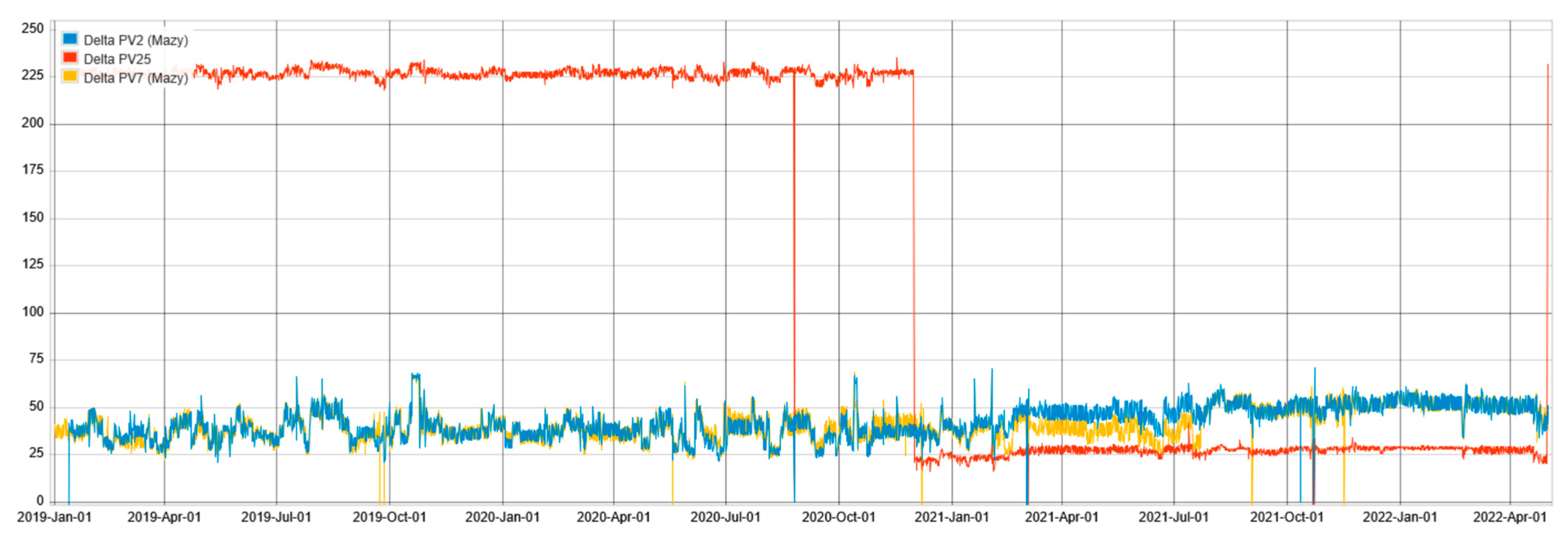

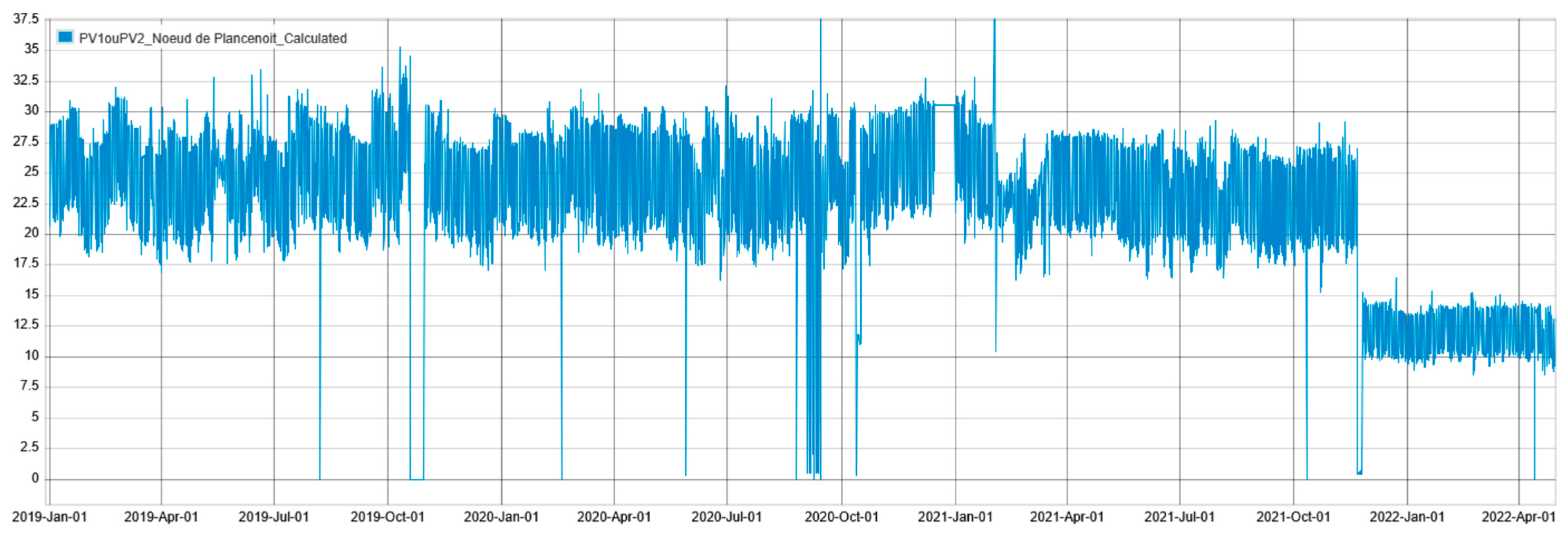
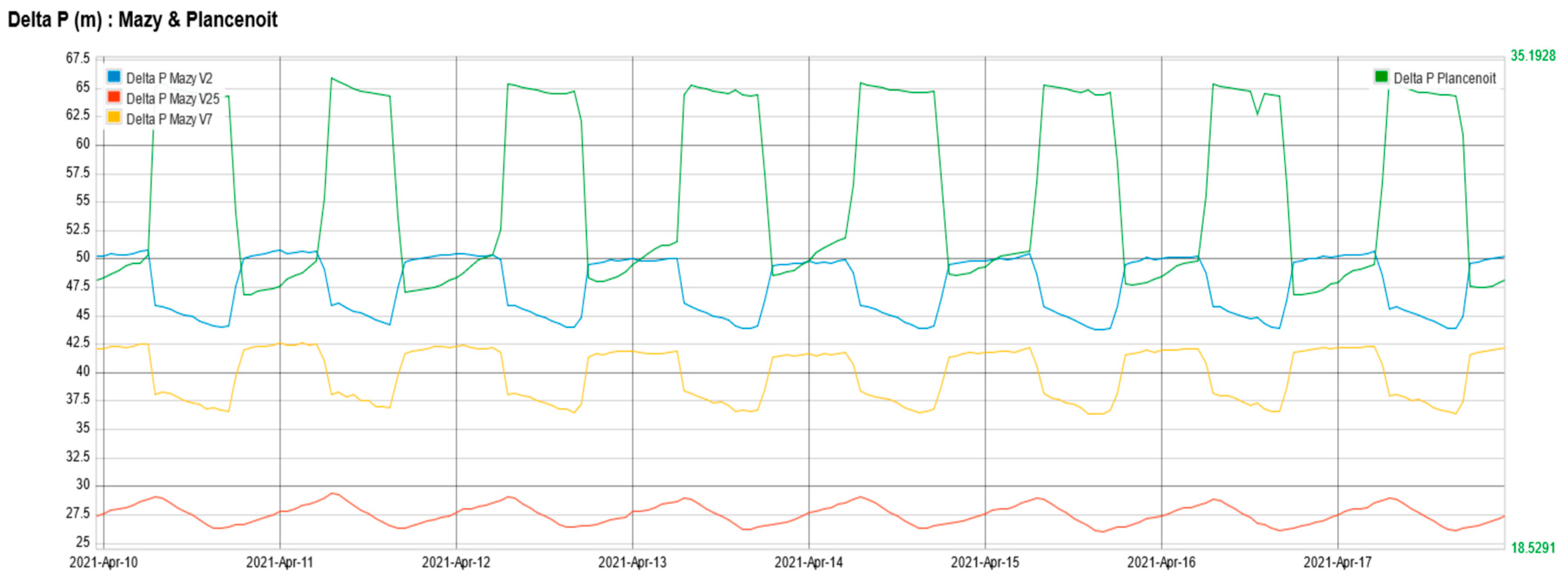
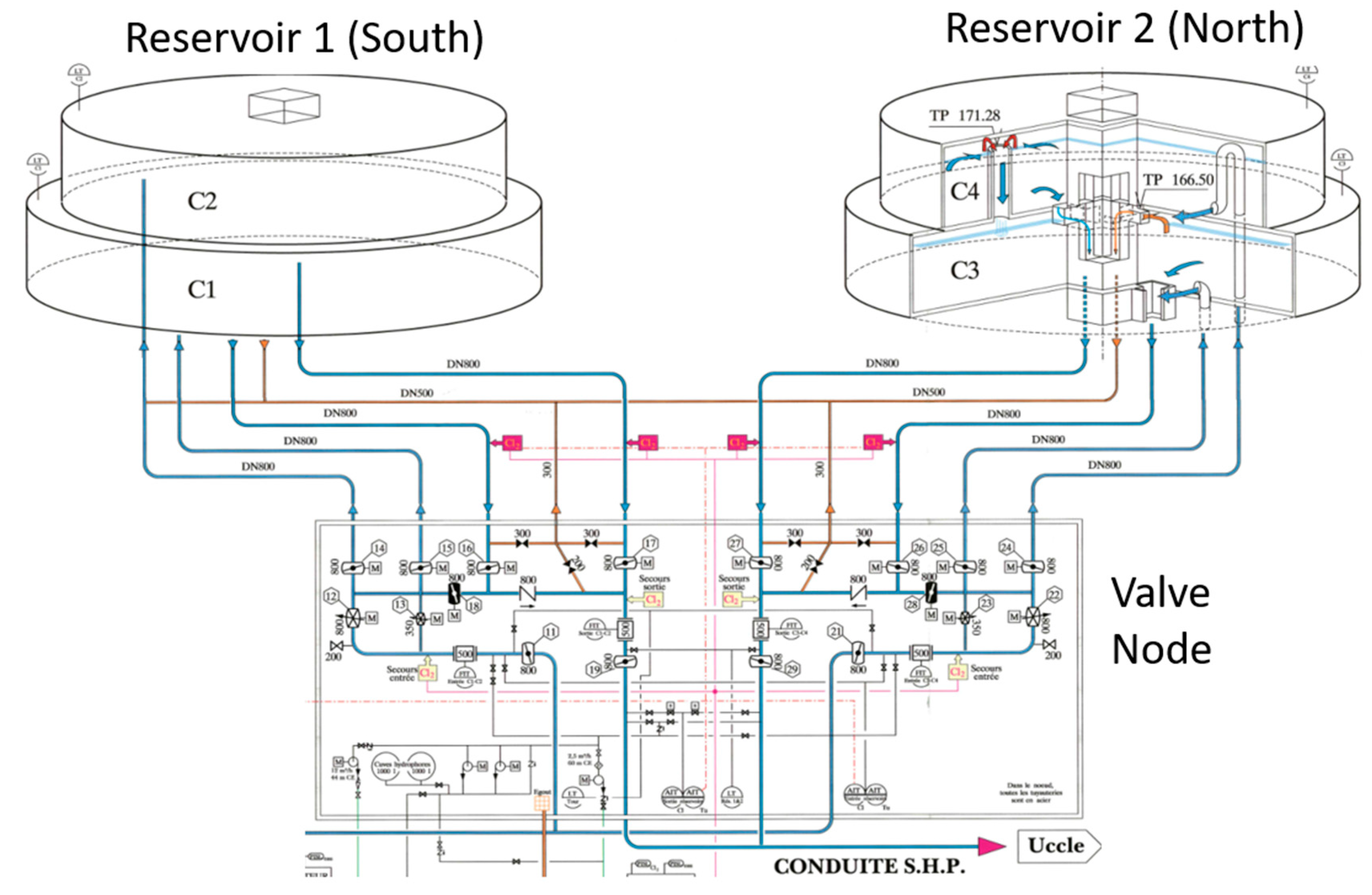
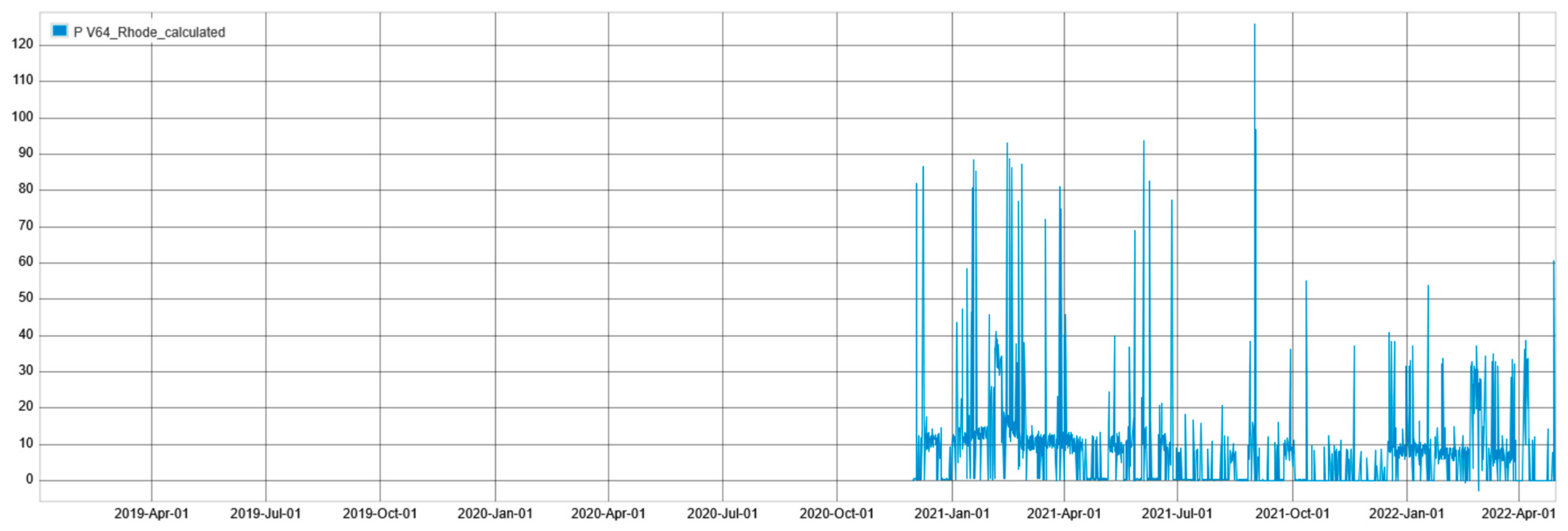
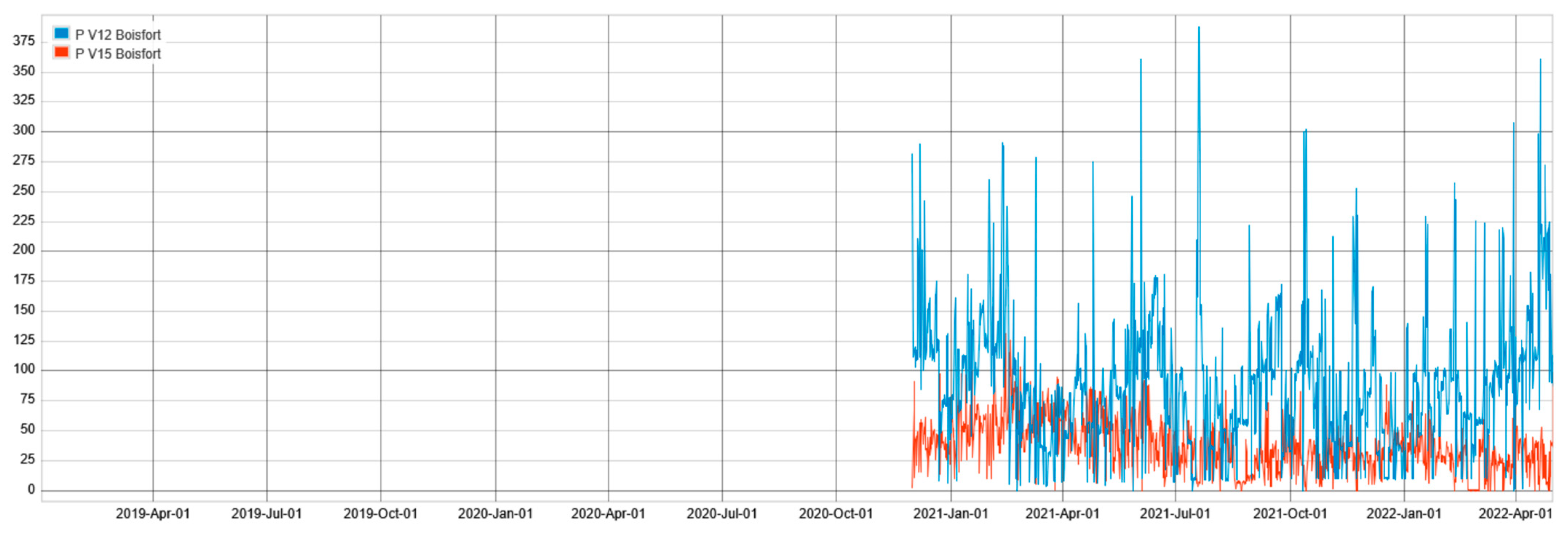
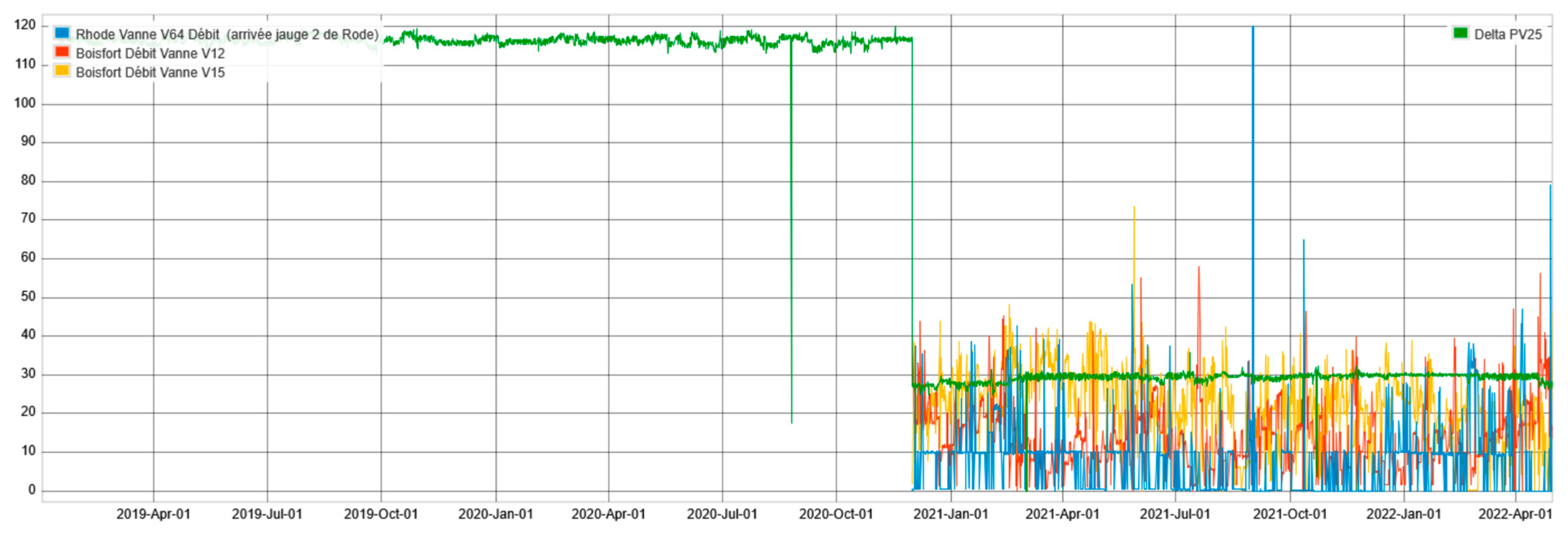
Disclaimer/Publisher’s Note: The statements, opinions and data contained in all publications are solely those of the individual author(s) and contributor(s) and not of MDPI and/or the editor(s). MDPI and/or the editor(s) disclaim responsibility for any injury to people or property resulting from any ideas, methods, instructions or products referred to in the content. |
© 2025 by the authors. Licensee MDPI, Basel, Switzerland. This article is an open access article distributed under the terms and conditions of the Creative Commons Attribution (CC BY) license (https://creativecommons.org/licenses/by/4.0/).
Share and Cite
Nuc, F.; Hendrick, P. Analysis of Energy Recovery Out of the Water Supply and Distribution Network of the Brussels Capital Region. Energies 2025, 18, 3777. https://doi.org/10.3390/en18143777
Nuc F, Hendrick P. Analysis of Energy Recovery Out of the Water Supply and Distribution Network of the Brussels Capital Region. Energies. 2025; 18(14):3777. https://doi.org/10.3390/en18143777
Chicago/Turabian StyleNuc, François, and Patrick Hendrick. 2025. "Analysis of Energy Recovery Out of the Water Supply and Distribution Network of the Brussels Capital Region" Energies 18, no. 14: 3777. https://doi.org/10.3390/en18143777
APA StyleNuc, F., & Hendrick, P. (2025). Analysis of Energy Recovery Out of the Water Supply and Distribution Network of the Brussels Capital Region. Energies, 18(14), 3777. https://doi.org/10.3390/en18143777






